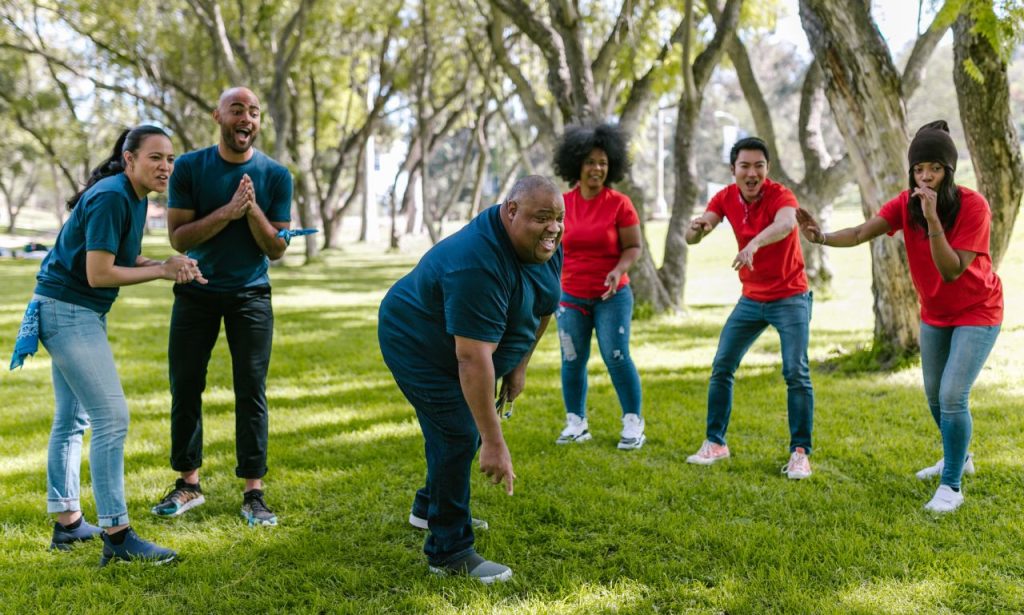Team building has evolved far beyond the traditional trust falls and awkward icebreakers. In a rapidly changing work environment—where remote and hybrid setups dominate—companies must innovate to foster real team bonds and employee engagement. This article explores innovative ways of team building among employees, from leveraging online collaboration platforms to tailoring personalized approaches that accommodate diverse personalities and work styles. Whether your team works in an office or remotely, these strategies will help you create a culture of trust, collaboration, and fun that ultimately drives success.
Online Collaboration Platforms
The shift toward digital workplaces has pushed team building into virtual spaces. Tools like Microsoft Teams, Slack, and Zoom aren’t just for meetings; they’ve become hubs for team interaction and engagement. These platforms enable real-time brainstorming sessions, virtual trivia nights, and even digital scavenger hunts that encourage team members to connect beyond work tasks.
Online collaboration platforms can also integrate cloud-based desktop virtualization, allowing remote teams to access shared resources effortlessly. When used creatively, they bridge the gap between physical distance and team dynamics, fostering an environment where employees feel connected and motivated.
A great example is how some companies host regular “Hack days” through these platforms, where cross-functional teams collaborate on creative projects outside their daily routine. This approach not only promotes professional development but also strengthens interpersonal relationships.
Gamification in Team Activities

Adding an element of play to work has proven powerful in boosting employee engagement. Gamification transforms mundane team-building activities into exciting challenges. Incorporating games like escape rooms, murder mystery dinners, or even simple paper chains competitions can spark enthusiasm.
Gamification isn’t just fun—it encourages problem-solving, collaboration, and quick thinking. For example, virtual escape rooms adapted for remote teams require communication and trust, key components of effective teamwork. When teams feel challenged but supported, their cohesion and productivity improve significantly.
Another fun idea is the Egg Drop challenge, which pushes teams to engineer a device that protects an egg from breaking when dropped. This hands-on task encourages creativity and teamwork while breaking up the monotony of the office environment.
Setting Clear Goals and Expectations
No team-building effort will succeed without clarity. When team members understand the purpose behind activities, they engage more fully. Setting clear goals and expectations means explaining how these activities tie into broader company culture and organizational objectives.
For example, if a brainstorming session is part of a team-building day, leaders should clarify the session’s focus and desired outcomes. This approach keeps discussions purposeful and helps team members see their role within the larger mission.
Clear goals also reduce confusion and frustration. When employees know what’s expected, they’re more likely to participate actively and take away meaningful insights from the experience.
Promoting a Positive Work Culture
Culture isn’t built overnight. It takes consistent effort to promote positivity and respect among team members. Encouraging employee recognition and celebrating small wins can reinforce a healthy company culture.
Regular rituals, such as shout-outs during team meetings or monthly employee awards, foster a sense of appreciation and belonging. These practices build trust, which is the foundation of effective teamwork.
Moreover, positive culture reduces conflict and encourages collaboration. Teams that feel safe and valued are more willing to share ideas and provide honest feedback, driving continuous improvement.
Encouraging Diversity and Inclusion
Diversity and inclusion are more than buzzwords—they’re critical to team success. Diverse teams bring a range of perspectives that spark innovation and creative problem-solving.
Incorporating Diversity & Inclusion into team-building activities ensures every voice is heard. This might include community-based team-building activities that reflect different cultural backgrounds or icebreaker team building activities designed to highlight personal stories and experiences.
When employees feel included, their engagement and loyalty increase. Companies that prioritize inclusivity often see higher employee satisfaction and stronger organizational culture.
Understanding Team Personalities
Every team is a mosaic of personalities. Tools like the Myers-Briggs Type Indicator can help leaders understand individual preferences and tailor activities accordingly. Recognizing differences in communication styles and motivators allows for more effective collaboration.
For example, introverted team members might prefer smaller group activities or one-on-one discussions rather than large, noisy events. On the other hand, extroverts often thrive in brainstorming sessions or group games.
Understanding these dynamics leads to personalized team building approaches that maximize participation and satisfaction. When team members feel their unique traits are respected, they contribute more confidently and authentically.
Adapting to Remote and Hybrid Work Environments
Remote and hybrid teams face unique challenges when it comes to team building. Distance can create feelings of isolation, making it crucial to find innovative ways to engage employees.
Virtual team-building activities have exploded in popularity—from online book clubs to Show and Tell sessions that encourage personal storytelling. These formats nurture connection without physical proximity.
Furthermore, investing in virtual communication tools and an employee app can streamline interaction and keep remote team members in the loop. Companies using cloud-based digital experience platforms provide seamless access to resources, fostering collaboration regardless of location.
For hybrid teams, combining in-person and virtual activities ensures everyone stays engaged. Scheduling regular training sessions or team rituals that accommodate all members is key.
Personalized Team Building Approaches
No one-size-fits-all solution exists in team building. Personalization is essential for success. Tailoring activities to your team’s interests, work styles, and goals creates a more meaningful experience.
Surveys and employee feedback can identify preferred activities, whether it’s Trivia nights, professional development workshops, or community volunteering. Mixing different formats keeps team-building fresh and engaging.
This approach also respects time constraints. Not everyone enjoys lengthy events, so offering bite-sized team-building moments throughout the workweek can be more effective.
Encouraging Open Feedback and Communication
Honest communication is the lifeblood of thriving teams. Encouraging open feedback allows employees to share their thoughts on team-building activities and overall dynamics.
Leaders should foster an environment where constructive criticism is welcomed and acted upon. This practice improves future planning and builds trust.
Regular check-ins, anonymous surveys, or open forums provide multiple channels for feedback. When team members feel heard, their engagement deepens.
Balancing Fun with Objectives
While fun is a critical component of team building, activities must align with business objectives. Striking the right balance ensures time is well spent and outcomes are measurable.
For example, icebreaker team building activities can warm up a group before a serious brainstorming session. Combining lighthearted moments with goal-oriented tasks enhances team dynamics and maintains high motivation.
This balance prevents team-building days from feeling like forced “fun” or wasted hours. Instead, they become valued opportunities to strengthen skills and relationships.
Measuring the Impact of Team Building Activities

How do you know if your efforts are paying off? Measuring the impact of team building activities is essential to justify investment and improve programs.
Surveys assessing employee satisfaction, engagement scores, and retention rates can offer quantitative data. Qualitative insights, like observing improved collaboration or conflict resolution, also matter.
Companies with mature organizational cultures often integrate team-building outcomes into performance reviews or leadership development plans.
Conclusion
Innovative ways of team building among employees are more important than ever. Whether through digital collaboration tools, gamified challenges, or personalized approaches, the goal remains the same: build trust, enhance communication, and foster a positive work culture. By adapting to diverse personalities and modern work environments, companies can create meaningful connections that drive productivity and satisfaction. How will you reimagine your team-building efforts to meet today’s challenges?
FAQs
A: Online trivia nights, virtual escape rooms, Show and Tell sessions, and online scavenger hunts are popular virtual options.
A: It fosters trust, enhances communication, and builds a positive company culture, making employees feel valued and connected.
A: Diverse teams bring varied perspectives that boost creativity and innovation, making team efforts more effective.
A: Use employee feedback, engagement surveys, retention data, and observe improvements in team dynamics.
A: Yes, but they must be adapted to virtual formats or hybrid models to ensure inclusivity and engagement.




